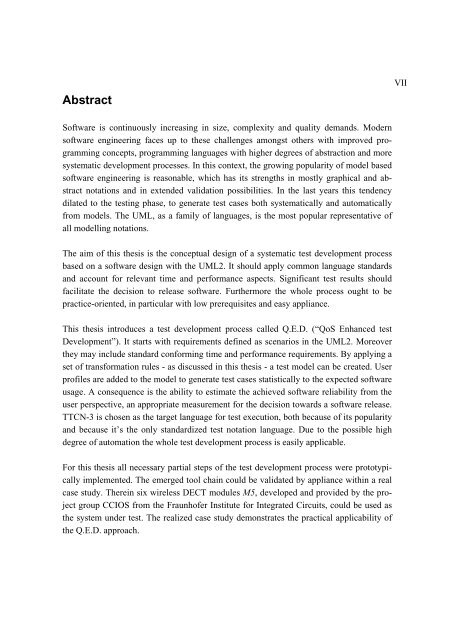Dokument 1.pdf - Opus - Friedrich-Alexander-Universität Erlangen ...
Dokument 1.pdf - Opus - Friedrich-Alexander-Universität Erlangen ...
Dokument 1.pdf - Opus - Friedrich-Alexander-Universität Erlangen ...
Sie wollen auch ein ePaper? Erhöhen Sie die Reichweite Ihrer Titel.
YUMPU macht aus Druck-PDFs automatisch weboptimierte ePaper, die Google liebt.
Abstract<br />
Software is continuously increasing in size, complexity and quality demands. Modern<br />
software engineering faces up to these challenges amongst others with improved programming<br />
concepts, programming languages with higher degrees of abstraction and more<br />
systematic development processes. In this context, the growing popularity of model based<br />
software engineering is reasonable, which has its strengths in mostly graphical and abstract<br />
notations and in extended validation possibilities. In the last years this tendency<br />
dilated to the testing phase, to generate test cases both systematically and automatically<br />
from models. The UML, as a family of languages, is the most popular representative of<br />
all modelling notations.<br />
The aim of this thesis is the conceptual design of a systematic test development process<br />
based on a software design with the UML2. It should apply common language standards<br />
and account for relevant time and performance aspects. Significant test results should<br />
facilitate the decision to release software. Furthermore the whole process ought to be<br />
practice-oriented, in particular with low prerequisites and easy appliance.<br />
This thesis introduces a test development process called Q.E.D. (“QoS Enhanced test<br />
Development”). It starts with requirements defined as scenarios in the UML2. Moreover<br />
they may include standard conforming time and performance requirements. By applying a<br />
set of transformation rules - as discussed in this thesis - a test model can be created. User<br />
profiles are added to the model to generate test cases statistically to the expected software<br />
usage. A consequence is the ability to estimate the achieved software reliability from the<br />
user perspective, an appropriate measurement for the decision towards a software release.<br />
TTCN-3 is chosen as the target language for test execution, both because of its popularity<br />
and because it’s the only standardized test notation language. Due to the possible high<br />
degree of automation the whole test development process is easily applicable.<br />
For this thesis all necessary partial steps of the test development process were prototypically<br />
implemented. The emerged tool chain could be validated by appliance within a real<br />
case study. Therein six wireless DECT modules M5, developed and provided by the project<br />
group CCIOS from the Fraunhofer Institute for Integrated Circuits, could be used as<br />
the system under test. The realized case study demonstrates the practical applicability of<br />
the Q.E.D. approach.<br />
VII
















